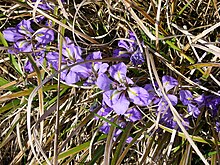Iris unguicularis
| Iris unguicularis | |
|---|---|

| |
| Scientific classification | |
| Kingdom: | Plantae |
| Clade: | Tracheophytes |
| Clade: | Angiosperms |
| Clade: | Monocots |
| Order: | Asparagales |
| Family: | Iridaceae |
| Genus: | Iris |
| Subgenus: | Iris subg. Limniris |
| Section: | Iris sect. Limniris |
| Series: | Iris ser. Unguiculares |
| Species: | I. unguicularis |
| Binomial name | |
| Iris unguicularis | |
| Synonyms[1] | |
| |
Iris unguicularis (syn. Iris stylosa), the Algerian iris, is a rhizomatous flowering plant in the genus Iris, native to Algeria, Greece, Turkey, Western Syria, and Tunisia. It grows to 30 centimetres (12 in), with grassy evergreen leaves, producing pale lilac or purple flowers with a central band of yellow on the falls. The flowers appear in winter and early spring. They are fragrant, with pronounced perianth tubes up to 20 cm (7.9 in) long.[2][3]
This plant is widely cultivated in temperate regions, and numerous cultivars have been selected for garden use, including a slightly more tender white form 'Alba', and a dwarf variety I. unguicularis subsp. cretensis. The cultivar 'Mary Barnard'[4] has gained the Royal Horticultural Society's Award of Garden Merit.[5]
Chemistry
In 2013, a chemical analysis study was carried on Iris loczyi and Iris unguicularis as both plants are known as medicinally important.[6][7] The rhizome of Iris unguicularis contains 1,3-O-diferuloylsucrose, 5,7-dihydroxy-6-methoxychromone, irilone, 4′,5,7-trihydroxy-6-methoxyflavanone, tectorigenin, kaempferol, 4′,5,7-trihydroxy-3′,8-dimethoxyflavanone, 8-methoxyeriodictyol, hispidulin and mangiferin.[8]
References
- ^ "Iris unguicularis Poir. is an accepted name". theplantlist.org (The Plant List). 23 March 2013. Retrieved 26 January 2015.
- ^ RHS A-Z encyclopedia of garden plants. United Kingdom: Dorling Kindersley. 2008. p. 1136. ISBN 978-1405332965.
- ^ "AGS Plant Encyclopaedia - Iris unguicularis". Alpine Garden Society. Retrieved 20 May 2013.
- ^ "RHS Plant Selector - Iris unguicularis 'Mary Barnard'". Royal Horticultural Society. Retrieved 20 February 2020.
- ^ "AGM Plants - Ornamental" (PDF). Royal Horticultural Society. July 2017. p. 55. Retrieved 13 March 2018.
- ^ Mosihuzzmana, Mohmmed; Naheedb, Suad; Hareema, Sumaira; Taliba, Sumaira; Abbasc, Ghulam; Khana, Shamsun Nahar; Choudharya, Muhammad Iqbal; Sener, Bilge; Tareene, Rasool Baksh; Israra, Mudassir (27 February 2013). "Studies on α-glucosidase inhibition and anti-glycation potential of Iris loczyi and Iris unguicularis". Life Sciences. 92 (3). Elsevier: 187–192. doi:10.1016/j.lfs.2012.11.022. PMID 23270944.
- ^ Q. Ashton Acton Glucosidases—Advances in Research and Application: 2013 Edition , p. 271, at Google Books
- ^ New and Known Constituents from Iris unguicularis and Their Antioxidant Activity. Atta-ur-Rahman, Sumaira Hareem, M. Iqbal Choudhary, Bilge Sener, Ahmed Abbaskhan, Hina Siddiqui, Shazia Anjum, Ilkay Orhan, Ilhan Gurbuz and Filiz Ayanoglu, HeteroCycles, 2010, Special issue, Vol 82, No. 1, pages 813-824, doi:10.3987/COM-10-S(E)6
